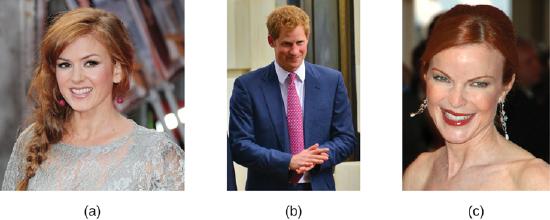17.4: What are Psychological Disorders?
- Page ID
- 137194
- Describe how psychological disorders are defined, as well as the inherent difficulties in doing so
A psychological disorder is a condition characterized by abnormal thoughts, feelings, and behaviors. Psychopathology is the study of psychological disorders, including their symptoms, etiology (i.e., their causes), and treatment. The term psychopathology can also refer to the manifestation of a psychological disorder. Although consensus can be difficult, it is extremely important for mental health professionals to agree on what kinds of thoughts, feelings, and behaviors are truly abnormal in the sense that they genuinely indicate the presence of psychopathology. Certain patterns of behavior and inner experience can easily be labeled as abnormal and clearly signify some kind of psychological disturbance. The person who washes his hands 40 times per day and the person who claims to hear the voices of demons exhibit behaviors and inner experiences that most would regard as abnormal: beliefs and behaviors that suggest the existence of a psychological disorder. But, consider the nervousness a person may feel when talking to an attractive love interest or the loneliness and longing for home a freshman may experience during their first semester of college—these feelings may not be regularly present, but they fall in the range of normal. So, what kinds of thoughts, feelings, and behaviors represent a true psychological disorder? Psychologists work to distinguish psychological disorders from inner experiences and behaviors that are merely situational, idiosyncratic, or unconventional.
Definition of a Psychological Disorder
Perhaps the simplest approach to conceptualizing psychological disorders is to label behaviors, thoughts, and inner experiences that are atypical, distressful, dysfunctional, and sometimes even dangerous, as signs of a disorder. For example, if you ask a classmate for a date and you are rejected, you probably would feel a little dejected. Such feelings would be normal. If you felt extremely depressed—so much so that you lost interest in activities, had difficulty eating or sleeping, felt utterly worthless, and contemplated suicide—your feelings would be atypical, would deviate from the norm, and could signify the presence of a psychological disorder. Just because something is atypical, however, does not necessarily mean it is disordered.
For example, only about 4% of people in the United States have red hair, so red hair is considered an atypical characteristic (Figure 1), but it is not considered disordered, it’s just unusual. And it is less unusual in Scotland, where approximately 13% of the population has red hair (“DNA Project Aims,” 2012). As you will learn, some disorders, although not exactly typical, are far from atypical, and the rates in which they appear in the population are surprisingly high.

If we can agree that merely being atypical is an insufficient criterion for having a psychological disorder, is it reasonable to consider behavior or inner experiences that differ from widely expected cultural values or expectations as disordered? Using this criterion, a woman who walks around a subway platform wearing a heavy winter coat in July while screaming obscenities at strangers may be considered as exhibiting symptoms of a psychological disorder. Her actions and clothes violate socially accepted rules governing appropriate dress and behavior; these characteristics are atypical.
Cultural Expectations
Violating cultural expectations is not, in and of itself, a satisfactory means of identifying the presence of a psychological disorder. Since behavior varies from one culture to another, what may be expected and considered appropriate in one culture may not be viewed as such in other cultures. For example, returning a stranger’s smile is expected in the United States because a pervasive social norm dictates that we reciprocate friendly gestures. A person who refuses to acknowledge such gestures might be considered socially awkward—perhaps even disordered—for violating this expectation. However, such expectations are not universally shared. Cultural expectations in Japan involve showing reserve, restraint, and a concern for maintaining privacy around strangers. Japanese people are generally unresponsive to smiles from strangers (Patterson et al., 2007). Eye contact provides another example. In the United States and Europe, eye contact with others typically signifies honesty and attention. However, most Latin-American, Asian, and African cultures interpret direct eye contact as rude, confrontational, and aggressive (Pazain, 2010). Thus, someone who makes eye contact with you could be considered appropriate and respectful or brazen and offensive, depending on your culture (Figure 2).

Figure 2. Eye contact is one of many social gestures that vary from culture to culture. (credit: Joi Ito)
Hallucinations (seeing or hearing things that are not physically present) in Western societies is a violation of cultural expectations, and a person who reports such inner experiences is readily labeled as psychologically disordered. In other cultures, visions that, for example, pertain to future events may be regarded as normal experiences that are positively valued (Bourguignon, 1970). Finally, it is important to recognize that cultural norms change over time: what might be considered typical in a society at one time may no longer be viewed this way later, similar to how fashion trends from one era may elicit quizzical looks decades later—imagine how legwarmers or the big hair of the 1980s would go over on your campus today.
American Psychiatric Association (APA) Definition
According to the American Psychiatric Association (APA) (2013), a psychological disorder is a condition that is said to consist of the following:
- There are significant disturbances in thoughts, feelings, and behaviors. A person must experience inner states (e.g., thoughts and/or feelings) and exhibit behaviors that are clearly disturbed—that is, unusual, but in a negative, self-defeating way. Often, such disturbances are troubling to those around the individual who experiences them. For example, an individual who is uncontrollably preoccupied by thoughts of germs spends hours each day bathing, has inner experiences, and displays behaviors that most would consider atypical and negative (disturbed) and that would likely be troubling to family members.
- The disturbances reflect some kind of biological, psychological, or developmental dysfunction. Disturbed patterns of inner experiences and behaviors should reflect some flaw (dysfunction) in the internal biological, psychological, and developmental mechanisms that lead to normal, healthy psychological functioning. For example, the hallucinations observed in schizophrenia could be a sign of brain abnormalities.
- The disturbances lead to significant distress or disability in one’s life. A person’s inner experiences and behaviors are considered to reflect a psychological disorder if they cause the person considerable distress, or greatly impair his ability to function as a normal individual (often referred to as functional impairment, or occupational and social impairment). As an illustration, a person’s fear of social situations might be so distressing that it causes the person to avoid all social situations (e.g., preventing that person from being able to attend class or apply for a job).
- The disturbances do not reflect expected or culturally approved responses to certain events. Disturbances in thoughts, feelings, and behaviors must be socially unacceptable responses to certain events that often happen in life. For example, it is perfectly natural (and expected) that a person would experience great sadness and might wish to be left alone following the death of a close family member. Because such reactions are in some ways culturally expected, the individual would not be assumed to signify a mental disorder.
Try It
Query \(\PageIndex{1}\)
Query \(\PageIndex{2}\)
Query \(\PageIndex{3}\)
Query \(\PageIndex{4}\)
Some believe that there is no essential criterion or set of criteria that can definitively distinguish all cases of disorder from nondisorder (Lilienfeld & Marino, 1999). In truth, no single approach to defining a psychological disorder is adequate by itself, nor is there universal agreement on where the boundary is between disordered and not disordered. From time to time we all experience anxiety, unwanted thoughts, and moments of sadness; our behavior at other times may not make much sense to ourselves or to others. These inner experiences and behaviors can vary in their intensity, but are only considered disordered when they are highly disturbing to us and/or others, suggest a dysfunction in normal mental functioning, and are associated with significant distress or disability in social or occupational activities.
Try It
Query \(\PageIndex{5}\)
Query \(\PageIndex{6}\)
Query \(\PageIndex{7}\)
Think it Over
- Identify a behavior that is considered unusual or abnormal in your own culture that would be considered normal and expected in another culture.
Glossary
atypical: describes behaviors or feelings that deviate from the norm
etiology: cause or causes of a psychological disorder
psychological disorder: condition characterized by abnormal thoughts, feelings, and behaviors
psychopathology: study of psychological disorders, including their symptoms, causes, and treatment; manifestation of a psychological disorder
Contributors and Attributions
CC LICENSED CONTENT, SHARED PREVIOUSLY
- What Are Psychological Disorders?. Authored by: OpenStax College. Located at: https://openstax.org/books/psychology-2e/pages/15-1-what-are-psychological-disorders. License: CC BY: Attribution. License Terms: Download for free at https://openstax.org/books/psycholog...1-introduction

